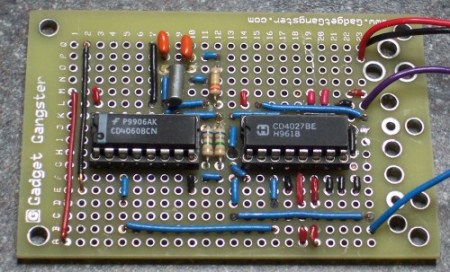
Check out this nice simple method of achieving a 1Hz timebase. This is basically a lesson in dividing crystal frequencies in circuits to get the desired result. In this case, they are starting with a 32.768KHz crystal and dividing it down. Instead of using an NE555 like many projects, he chose to go a direction that would yield results less prone to drifting with temperature variation. The method chosen was a CD4060 frequency divider, basically just a chain of flipflops. The divider is one step short of getting to the desired result so an additional flipflop has to be added. This is pretty basic stuff, but a great read. They go into detail as to how it all works and why you would use this method.
Pssst, hey, remember that time I told you to just use a 1Hz crystal? yeah, we can laugh at that again.
[via HackedGadgets]














The theory and explanation are well written, the circuit presents some good working principles.
But it is rather useless for a project with modern components.
I so want to see a 1Hz Crystal. That would be so cool. Just need a mountain of quartz and Hover dam to power it. But that would be something to see.
If you need 1Hz from 32,768kHz, why not hack the board out of a $2 “analog” clock and pick-off the pulses going to the stepper.
Yeah, the $2 hacked clock may have a resonator instead of a crystal, but venture to guess what the Author has is really a resonator anyway. A “Real 1Hz” reference has to take into account a LOT of things, accuracy, resolution (jitter >< phase-noise) etc. etc.
But anyway… nice to see HaD posting something like this instead of a deluge of Apple iPhone crap.
@Drone: Ikea sells a clock for 99 cents that uses a crystal. (32,768kHz)
We just had a sample batch of 0805 package 32.768k crystals delivered at work. Nice progression.
And if you want accurate, get a $10 GPS module that puts out 1pps. :)
Hi Guys, I wrote the 1Hz project.
It was targeted at beginners just starting to move on from simple 555 circuits. It’s the timebase for a non-microcontroller freq counter. Interestingly, the freq counter tracks within 1 or 2 counts with my H/P bench counter from 1hz to 4MHz over a range of 50F to 100F. It’s actually more accurate than I expected, but I refuse to publish any great accuracy given the variability of clock crystals, and the lack of basic clock stabilization.
@JohnS_AZ
It think the term that everyone has been striving for (instead of saying 1Hz crystal) is 1Hz oscillator. Very different things.. ;)
Tweeks
If you use the CMOS 4521 you’ll only need one chip apart from the crystal (4,194,304Hz) and other small parts to acheive 7 frequencies ranging from 1/4Hz to 16Hz.
Another cheap source of a 32KHz->1Hz is a RTC chip. Many output a 1pps pulse without even the need to config them…
Simon.
@komradebob
Where do you get a $10 GPS module with a 1 hz output?
While I always appreciate analog circuits, This almost seems like “overkill” when you could program a small PIC with an internal oscillator to do it for a total parts count of 1.
Then again, some may argue that using a processor to make a 1hz clock is “overkill”. Those people don’t have boxes of free samples.
@tim – I think it depends on the application, if your circuit already has a ucontroller, then you might use that. But if your circuit doesn’t, then this approach means you don’t have to batch program IC’s.
@Tim: The internal oscillators in the PIC and AVR chips I’ve used have been RC affairs, so not very accurate and sensitive to temperature variations, though I suppose an external crystal wouldn’t increase the part count too significantly.
If you really need an accurate, temperature-compensated 1pps timebase, the DS3231 can be configured to output a 1Hz clock and stays accurate to a minute per year under varying temperature conditions.
@fred – Weird Stuff has them for $9.
http://www.weirdstuff.com/cgi-bin/item/20164
If you need to see how to hook it up, I wrote it up here:
http://www.correctivephrenology.com/blog/?p=14
Hard to beat for 1pps accuracy. I have 4 or 5 of them running around in different applications.
And, yes, you’ll need to add an antenna. :)